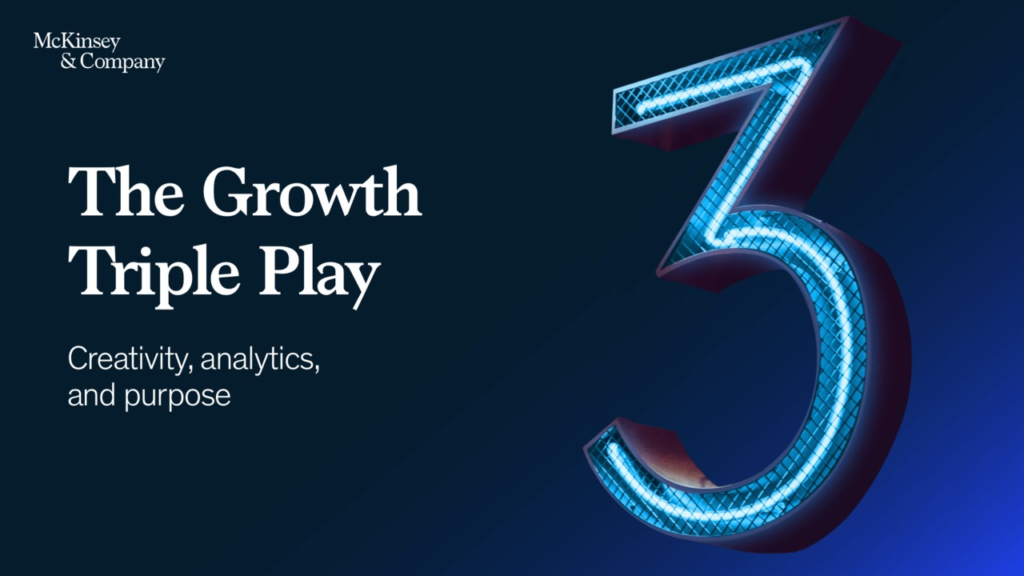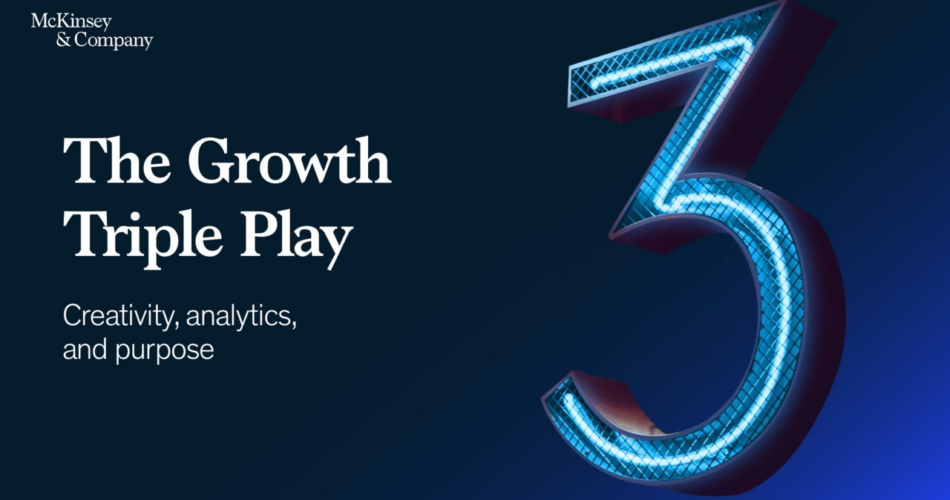
COVID-19 overturned lives and livelihoods across the globe, forcing people to find new ways of working, shopping, and playing. Homebound consumers abandoned deep-seated shopping habits overnight, going online in droves and compressing a decade’s worth of digital adoption into months.
Although businesses responded quickly to a flood of new online customers, they faced unprecedented disruption, with a staggering 75 percent of consumers trying new brands, products, and channels. These seismic shifts are transforming the role of marketers and marketing, and McKinsey research indicates that 78 percent of CEOs are counting on chief marketing officers (CMOs) to drive growth.
Marketing leaders have a once-in-a-generation opportunity to combine creativity, analytics, and purpose—the growth triple play—to help their companies grow at twice the rate of their peers. Brian Solis, Salesforce’s global innovation evangelist, keynote speaker, and best-selling author, shares his insights with McKinsey about the future of marketing and the interlocking roles these three elements play to boost growth.
Making marketing more experiential
McKinsey: When you look to the future of marketing, what do you see?
Brian Solis (31:41): We should start with what marketing is and what it shouldn’t be. At its core, it’s people on the other side of the screen and in front of us who all have expectations and aspirations.
The future of marketing is to understand what those aspirations are, whether that’s through analytics, or whether that’s just through talking to customers. The roles of creativity, purpose, and analytics in the future of marketing mean that marketing isn’t what it used to be, just like the future isn’t what it used to be.
(32:32): Marketing now becomes much more experiential—it’s what customers see, hear, and feel, and it plays a role in transforming the entire customer journey. If it’s driven by creativity, purpose, and insights that are actually representative of the very people we’re trying to engage, then that means marketing will help businesses grow by being relevant and empathetic. And that is what customers are looking for.
Creativity + analytics + purpose = innovation and growth
McKinsey: How can marketers harness creativity, analytics, and purpose to drive growth?
Brian Solis (02:41): Growth is driven by customer success, success is driven by engagement, and engagement defines customer experiences. In order to deliver the types of experiences that customers want, we need analytics.
At Salesforce, we talk about building a customer-360 company, which is organizing literally around the customer to deliver real-time value throughout their journey and throughout their life cycle. I think the pandemic highlighted for everyone that there are real people on the other side of the screen, and that we all suffered, learned, and grew through this as individuals, and also as markets.
We also realized that personalized engagement is really what customer centricity means. It’s not about transactions, which is how marketers operated and measured before. But when you add purpose, a set of values, a set of things which we can align around between business and customers, that changes the entire dynamic, and that is really what customers are looking for in brands.
(05:20) The thing about growth is that you can’t have it unless businesses help you drive it. And in order to help businesses collaborate and co-create toward growth, we have to really understand them. One of the pillars here in the future of marketing, which is purpose, means that we have to understand not only what values we represent as a business, but what values customers stand for.
Salesforce found that 61 percent of customers have stopped doing business with a brand because its values did not align with theirs. So customer loyalty is up for grabs, and that means acquisition and retention are more important than ever.
Thinking like a customer-360 company
McKinsey: What capabilities or attributes will be critical to marketers in the future?
Brian Solis (07:58): I don’t believe that striving toward normalcy should be any brand’s ambition right now.
This is an opportunity to create and invent and innovate. The attribute that businesses need to succeed in this regard is to really start thinking like a customer-360 company, which means that customer insights not only have to be at the center, they also have to be empathized with. I call this digital empathy, which is using data in a way that humanizes the people on the other side of the screen, but also reveals what life is like through their lens, not just through our goals, not just through our ambitions.
(08:51): That means that we have to teach things like empathy, creativity, and listening skills. It also means teaching creativity in terms of practicing new ideas and not being limited by the traditional marketing boundaries. That means making data available not just to the marketers, but to anyone throughout the organization who touches the customer, because everything now becomes marketing.
I refer to this new journey as the ignite moment. Once you have someone’s attention and know their intention, you can deliver the best, most personalized, efficient, convenient, and wow experience possible that wasn’t available to us before. It is available to us now, and that is why the three pillars of creativity, purpose, and analytics, are really powered by digital empathy.
Using analytics to understand “accidental narcissists”
McKinsey: How should marketing leaders approach customer experience?
Brian Solis: (10:21): For a marketer to build an effective customer experience, they need to be driven by the very things that help them make their customers successful.
(11:03) The bar is very high. I call customers today “accidental narcissists” because technology has conditioned them to believe that they can have whatever they want, whenever they want it, wherever they are, within minutes. Analytics are going to help us understand those trends in real time. With AI and automation, we can actually understand how to predict and deliver against those trends ahead of time.
We then need digital empathy to humanize those things and look inward to inspire our sense of purpose. It’s not good enough anymore to come up with a mission statement and hang it on the wall.
We have to be driven by what matters to people and also what we stand for, because together we are a community. It isn’t just a market—it’s a relationship between customers and businesses, powered by marketers creating the experiences that bind us within this community.
What it means to start with the customer
McKinsey: What advice do you have for organizations on where to start this journey?
Brian Solis: (13:37) The number-one question that I get from executives—whether it’s the head of service, CMO, or CIO—is where do I start? Start with the customer. But don’t stop with the customer. You also have to remember that the employee is also part of the customer experience. In fact, employee experience plus customer experience—EX+CX—is what will equal growth. Because it’s that humanization of those experiences that is going to inspire what you stand for. It’s going to inspire your purpose.
This is a time to reimagine your brand based on that purpose and those values. You also have to be bold, inventive, and innovative. You have to be willing to take a stand and say there are customers you don’t want to do business with. And in order to get there, you need data-driven empathy. Data has to be at the center, and it has to be solid, consistent, and representative of the customer’s experience, including their journey and aspirations.
Data-driven empathy is about humanizing data, but human empathy is about seeing and feeling the world others do. Those pieces together—digital plus the human side of engagement—are what I believe will help marketers and the C-suite understand what to prioritize, where to invest, where to experiment, and what to unlearn and let go. Only then can we start becoming a human-centered brand empowered by personalization, analytics, technology, and innovation.
Transforming the CMO into a unifier
McKinsey: How will the role of the CMO evolve in the future?
Brian Solis: (36:42) Certainly, before the pandemic, the CMO was already taxed with doing so much around digital transformation, performance marketing, and big data to help companies thrive during the past 20 years.
Brian S (37:57): Now we have a much more conscious customer on the other side, who has been woken up by the pandemic and reminded that they’re empowered. They’ve been given the tools they need to make decisions, find solutions and services they wanted, live the life that they aspired to, and work the way they wanted to work.
This means the role of the CMO now has to be one that’s experience-driven, and human and empathetic at the core. But it needs to use technology in a way that delivers much more human, relevant, and meaningful experiences to customers throughout their journey.
I see the role of the CMO actually evolving into an experience officer that becomes cross-functional, empowering other customer-facing parts of the organization to deliver the consistent experience that customers need in those moments of truth.
That means the CMO has to act as a unifier to bring people to the table who didn’t necessarily collaborate before, because the customers’ experiences are actually the sum of all engagements they have with that brand. It’s not just one moment, it’s all the moments.
Someone has to be the conductor of all of this, to put their arms around all of this and say, “This is the standard for which we’re engaging,” so that we’re branding, marketing, and selling across this standard—and measuring that experience for the customer. And since it’s about experience, the unifier has to be the CMO.


Source link


